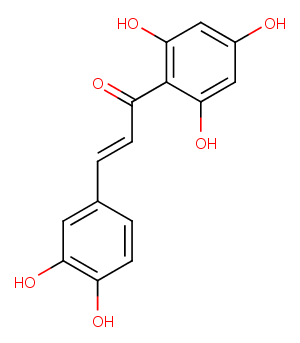Powder: -20°C for 3 years | In solvent: -80°C for 1 year


Eriodictyol chalcone has anti-plasmodial effects on P. falciparum growth.

| Pack Size | Availability | Price/USD | Quantity |
|---|---|---|---|
| 1 mg | Inquiry | $ 290.00 | |
| 5 mg | Inquiry | $ 1,400.00 |
| Description | Eriodictyol chalcone has anti-plasmodial effects on P. falciparum growth. |
| In vitro | The orange-yellow colouration of Coreopsis grandiflora is mainly provided by the 6'-deoxychalcone butein and its 4'-glucoside respectively, as well as the corresponding 4-deoxyaurones sulfuretin and leptosidin (7-methoxysulfuretin) and their 6-glucosides. Incubation of butein or sulfuretin with enzyme preparations from petals of Coreopsis grandiflora in the presence of uridine 5'-diphosphoglucose led in each case to the formation of one single product, which was identified as butein 4'-glucoside and sulfuretin 6-glucoside, respectively. The 6'-deoxychalcone isoliquiritigenin was a poor substrate. Glucosylation of hydroxyl groups in other positions was not observed. Naringenin chalcone and Eriodictyol chalcone were not accepted as substrates. The glucosylation reaction of butein and sulfuretin exhibited an optimum at pH 8.0 and 7.0, respectively. Bivalent ions like Mg2+ and Ca2+ stimulated only slightly, whereas the addition of Cu2+, Zn2+, N-ethylmaleimide and p- hydroxymercuribenzoate led to a total loss of enzyme activity. The apparent Km values for butein and sulfuretin were 146 and 44 μM, respectively. CONCLUSIONS:The specific enzyme activity increased slowly during bud and flower development and declined in the later stages. The highest specific activity was observed in open flowers with 30 mm diameter. The rates of the glucosylation reaction with butein and sulfuretin had similar patterns. |
| Molecular Weight | 288.25 |
| Formula | C15H12O6 |
| CAS No. | 14917-41-0 |
Powder: -20°C for 3 years | In solvent: -80°C for 1 year
You can also refer to dose conversion for different animals. More
bottom
Please see Inhibitor Handling Instructions for more frequently ask questions. Topics include: how to prepare stock solutions, how to store products, and cautions on cell-based assays & animal experiments, etc.
Eriodictyol chalcone 14917-41-0 Endocrinology/Hormones Microbiology/Virology Aromatase Anti-infection inhibit Inhibitor 17β-HSD inhibitor
